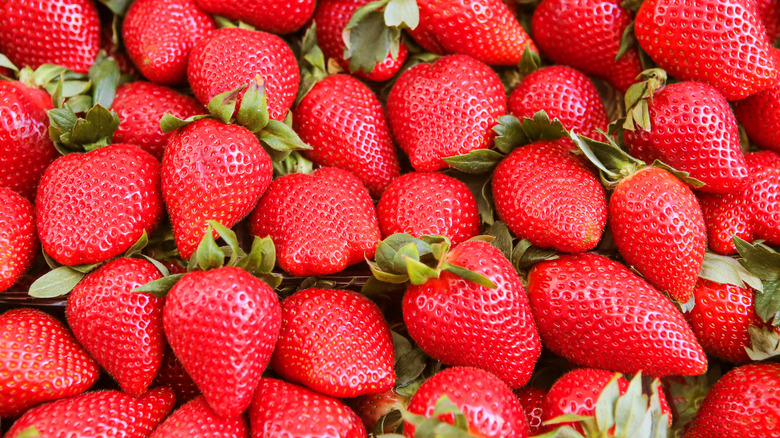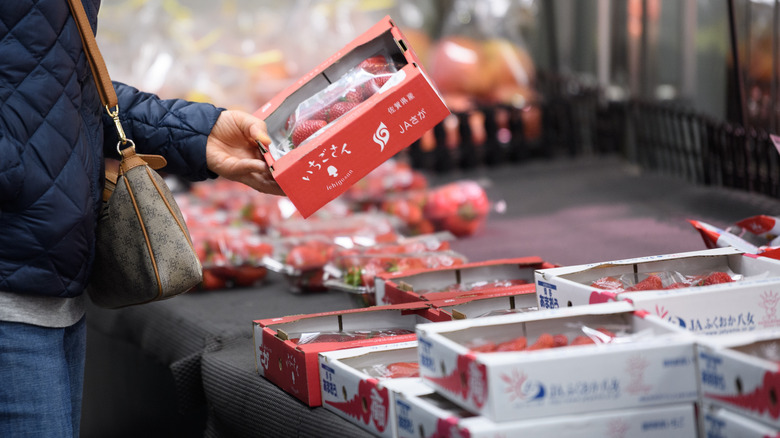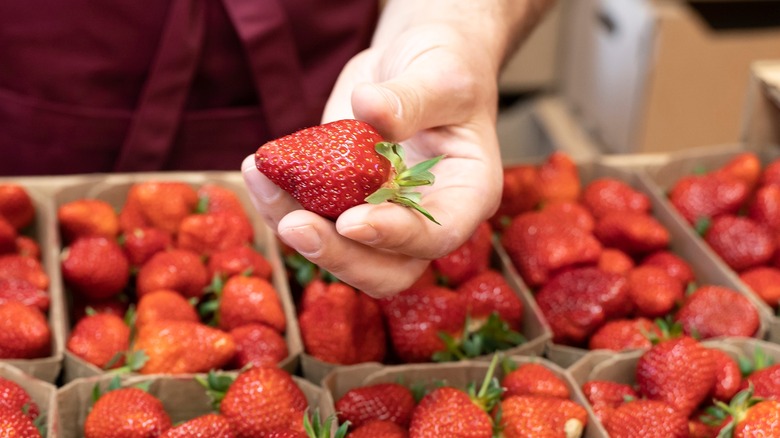Why You Should Choose Smaller Strawberries Over Larger Ones
When it comes to buying new things, you might tend to think bigger is always the better option, especially in the case of your favorite foods. Getting a jumbo bundle of bananas can mean one less trip to the store. Eating a huge slice of pizza can make for a more satisfactory experience than, say, splitting a slice with a friend. However, phrases like "less is more" exist for a reason. Not only that, but that pearl of common wisdom can even be applicable when it comes to some of the healthiest foods nature has to offer.
Take the beloved strawberry, for example. Finding that perfectly ripe, delicious bite of any fruit is never easy, and it can sometimes feel like a game of "Go Fish." If you find yourself perusing the fruit section at the grocery store, you might typically gravitate toward the biggest, plumpest containers of strawberries available, all to ensure you get the best quality. But surprisingly, those same strawberries might not actually be your best option. Here's why choosing smaller strawberries could be a better choice for your next summer recipe.
Smaller strawberries usually taste better
Many experts say you could have better luck getting a tastier bunch of strawberries by picking smaller-sized varieties of the fruit over bigger ones. According to The Oregonian, larger berries of all kinds tend to hold more water in them than most smaller ones. Having an excess of water in your fruit means that its juices end up being naturally diluted. When that happens, the deliciously tart flavor locked into each strawberry's makeup often won't taste as strong — especially in bigger strawberries compared to their smaller counterparts. A strawberry's small size has long been seen as a weakness, but many are now actually recognizing it as the fruit variety with a sweeter and just overall better taste, as noted by The Globe and Mail.
If a hyper-concentrated, sweet, and flavorful bite of summer is what you crave, then stop reaching for larger strawberries to pick. Instead, go for those smaller, underdog varieties. The latter may seem like a worse choice for your wallet and your tastebuds — but if you're thinking of good quality and taste over quantity, remember that looks can be deceiving the next time you're at the grocery store.
Looking beyond size
If you thought you could choose the best pick of fruit off of one simple observation, nice try. Mother nature just didn't make it that easy. Aside from a strawberry's size, another indicator that a berry is of peak freshness is color brightness, per NPR. To pick a good bunch of berries for your next picnic, avoid the fruit that has white streaks or spots seeping into its bright red hues — that's often a sign it was picked before it was ripe and ready for consumption. As a rule of thumb, make sure your berries are as red and green as Christmas, and you should be good to go.
Another thing to keep in mind when trying to choose the most well-rounded strawberries is to buy from a farm that is the most local to you to ensure peak freshness (via NPR). Berries grown closer to home are typically picked at the ripest time in their growing cycle compared to strawberries further away. This is because fruit shipped hundreds of miles from your local supermarket is usually picked earlier to ensure it retains some freshness on the journey to the market shelves. Unfortunately, it also means a piece of fruit's level of ripeness can be a total toss-up by the time it reaches your fridge. And hey, it's always good to remember that supporting local farmers is always a win!


